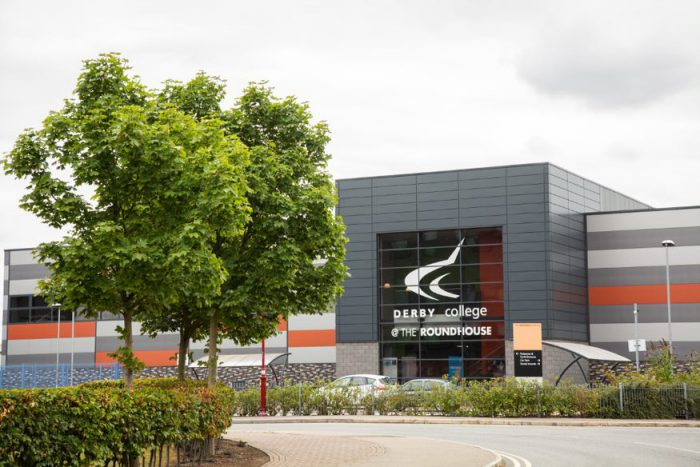Wood Product Manufacturing Operative Level 2
This occupation is found in the manufacturing sector, producing wood products for the construction and furniture industries. Supplying products to the housing, commercial, public and building sectors. Employers range from small to large, with a prevalence in the medium to large end of the market. Specialism in single product type is particularly common in the larger end of the market.
Course Summary

Course Information for Students
Who is this course for?
The broad purpose of the occupation is to produce high volume, repetitive, engineered products from timber. Presenting a wide and varied specification for both external and interior applications, products such as roofing components, windows, doors, door-sets, staircases, and other timber construction items including trussed rafters, spandrel panels, metal web beams, and I-beams. As well as utilising traditional materials, they use engineered and modified timbers to support product design and delivery, for example Accoya and Thermowood. They cut, layout and assemble materials, working to a specification. Depending on the product, they may install fixtures and fittings, apply finishes, and add glazing systems. Wood product manufacturing operatives typically work individually but can also form part of a larger production team and will report to the production supervisor/manager. Workplaces can be wide ranging from small workshops to large state of the art manufacturing facilities. In their daily work, an employee in this occupation interacts with customers, delivery personnel, design office, internal stores, and suppliers, depending on the size of the organisation. An employee in this occupation will be responsible for completing their own work to specification, with minimal supervision, ensuring they meet set deadlines. They are responsible for meeting quality requirements and working in accordance with health and safety and environmental considerations.
Typical job titles include, Finishing Operative, Machinist, and Sprayer and Assembler.
Entry Requirements
You need to be highly motivated and working in the maintenance or construction industry. Your job role and responsibilities should allow you to provide evidence for the knowledge, skills, and behaviours of this apprenticeship standard. DCG assessors will check your job description and advise accordingly.
You also need a GCSE grade D/3 or above in English and Maths.
You will undertake a basic skills test in literacy and numeracy.
A commitment to your own learning and performance in a working environment is essential.
Please note ‘In line with the Consumer Act and as articulated in our Student Protection Plan, we reserve the right to close a course, if there are insufficient students to make the course viable’.
What will you learn?
Knowledge, Skills and Behaviours
A Wood Product Manufacturing Operative will know:
- The wood product manufacturing industry, its background and importance.
- Commercial operations and how they contribute; key functions involved in the wood product manufacturing process.
- Manufacturing processes used to produce the end-product, such as selecting and using the appropriate machinery to perform the task/operation required, sequence of the production process including finishing, packaging and storing products.
- Types of customers (for example supplier, client) and customer requirements in terms of product quality, packaging and delivery, for example, satisfactory quality, fit for purpose and as described.
- Quality standards and product accreditation processes for wood product manufacture, for example ISO 9001:2, independent third-party accreditation.
- Health and safety, including the safe use of personal and respiratory protective equipment, local exhaust ventilation, compliance with the Health and Safety at Work Act, Provision and Use of Work Equipment Regulations (PUWER), Control of Substances Hazardous to Health (COSHH), organisational and statutory safe systems of work, controlling dust and manual handling.
- Different materials used to manufacture wood products and components, including different species and types of wood, composite panels (for example, Medium Density Fibreboard (MDF), plywood), adhesives, glass, ironmongery, fixings; their properties, characteristics, how they interrelate and the use of appropriate joining methods.
- How different products, for example doors, door-sets, windows, staircases and interior joinery are expected to perform, and how they interact with the wider built environment.
- Procedures for the safe handling and storage of wood components, products and glazing systems.
- Environmental and sustainability considerations, regulations and good practice, for example the appropriate disposal of waste, recycling of materials and efficient use of resources.
- Machines, equipment and tools used in wood product manufacturing including static machinery, portable powered tools and hand tools, what they are used for and their capabilities, correct set-up, use and storage, checks and adjustments, start-up and shut-down procedures.
- Principles and uses of Computer Numerically Controlled (CNC) machinery in wood product manufacturing, their programming requirements and associated tooling.
- Work and product specifications, what they are and how to use them.
- Checking and clarifying work requirements, including what needs checking and why.
- Types of faults and errors that do occur, investigation and rectification techniques.
- Techniques for measuring and cutting components and products.
- Assembly methods, how a product is assembled using prepared components from the manufacturing process, appropriate jointing and fixing methods to use and why (mortice and tenonning, butt jointing, screws, dowels, glues etc).
- Techniques for installing fixtures and fittings to wood products, for example ironmongery, seals, ancillary metal work and fixings, nail plates and staples, glazing.
- Different grit sizes and the sequence of sanding for full finish paint and stain systems.
- Different types of adhesives, and processes for their use including application methods.
- Techniques for applying specified finishes to components and products.
- Requirements for glazing wood products, for example, windows, door leaves, balustrading.
- Processes for handover to other manufacturing process functions, for example component production to assembly.
- Documentation requirements; written and verbal communication techniques.
A Wood Product Manufacturing Operative will be able to:
- Comply with health, safety and environmental requirements, for example, safe use of personal and respiratory protective equipment, local exhaust ventilation, statutory regulations and industry standards/codes of practice.
- Identify risks and hazards in the workplace and apply appropriate control measures.
- Comply with organizational and statutory environmental and sustainability considerations, for example, disposal of waste, recycling of materials and efficient use of resources.
- Communicate – verbal and/or written, for example with colleagues and/or customers.
- Plan work to undertake wood product manufacturing operations.
- Read and interpret specifications, diagrams, and work instructions, and following these instructions.
- Select the correct type and quantity of components and materials.
- Prepare the work area before undertaking the work.
- Identify faults and issues, for example, incorrect or defective wood, defective machinery; and applying solutions.
- Pack and store products and components.
- Select, set up and operate machinery, tools and equipment used to produce wood components.
- Prepare and operate Computer Numerically Controlled (CNC) equipment.
- Use and maintain jigs and templates for wood product manufacturing operations.
- Position wood components and apply manual and mechanical cramps to ensure products are secured and in accordance with the work specification.
- Assemble wood components to the work specification and given tolerances.
- Sand materials and de-nib.
- Apply adhesives to wood components.
- Apply finishes to wood products, for example, stains, sealers, basecoats and paint finishes.
- Install fixtures and fittings to wood products, for example, ironmongery, seals, ancillary metal work and fixings, nail plates and staples.
- Carry out glazing operations, for example, install glass to window or door.
- Check and inspect work to ensure it meets the work specification; undertake rectification or rework where necessary.
- Report work outcomes and/or problems.
- Complete the handover process to other manufacturing process functions/teams.
- Complete work documentation, for example, job sheets, time cards.
Behaviour required.
- Safety first attitude, for example, applies a safety-first attitude when undertaking the work.
- Adaptable, for example, willing to accept changing priorities and working requirements.
- Collaborates, for example, works with others.
- Pride in the workplace, for example, organizes work space efficiently and effectively.
- Self-motivated, for example, manages own time effectively.
- Quality workmanship, for example, works to agreed quality targets and standards.
How will you learn?
This delivery of this Standard is on a day release mode. Apprentices are released to the college 1 day a week throughout an academic calendar year.
Work based portfolio sessions and End Point Assessment sessions are planned throughout the apprenticeship.
Functional skills sessions would be additional to any structured timetable as needed.
Employer mentoring occurs in the workplace with the support and guidance of an assessor.
What will you need to bring with you?
You need safety boots and personal protective equipment, safety gloves and overalls, which should be supplied by your employer.
How will you be assessed?
You will be visited by your allocated assessor at your place of work and discussions with your employer will form supportive evidence of your training achievements as you work towards the gateway for completion.
You will then be assessed at the end of the training programme by completing an End-Point Assessment. This will assess how you can apply the skills, knowledge and behaviours acquired in your apprenticeship through the following three assessments carried out after you have completed the duration of on-programme learning:
- workplace observation and questioning
- interview, underpinned by portfolio of evidence
- multiple-choice test
Apprentices must complete, or have previously completed, recognised English and Mathematics Level 1 qualifications and aspire to achieve English and Mathematics Level 2 qualifications during the apprenticeship.
Where next?
Completing this apprenticeship standard will pave the way to employment and typical job titles include Finishing Operative, Machinist, and Sprayer and Assembler.
You can also progress to supervisory, management or professional and technical courses and qualifications.
Who do you contact for more information?
For more information contact Derby College on 0800 0280289 or enquiries@derby-college.ac.uk
Is there any financial support available?
There is no cost to the apprentice for an apprenticeship. If you are a smaller employer, you are eligible for government funding which will pay between 95% and 100% of the apprentice training costs. If you are a large employer, you can use your levy to pay for your apprenticeship training.
Course Information for Employers
Apprenticeship summary
Typical job titles include, Finishing Operative, Machinist, and Sprayer and Assembler.
The broad purpose of the occupation is to produce high volume, repetitive, engineered products from timber. Presenting a wide and varied specification for both external and interior applications, products such as roofing components, windows, doors, door-sets, staircases, and other timber construction items including trussed rafters, spandrel panels, metal web beams, and I-beams. As well as utilising traditional materials, they use engineered and modified timbers to support product design and delivery, for example Accoya and Thermowood. They cut, layout and assemble materials, working to a specification. Depending on the product, they may install fixtures and fittings, apply finishes, and add glazing systems. Wood product manufacturing operatives typically work individually but can also form part of a larger production team and will report to the production supervisor/manager. Workplaces can be wide ranging from small workshops to large state of the art manufacturing facilities. In their daily work, an employee in this occupation interacts with customers, delivery personnel, design office, internal stores, and suppliers, depending on the size of the organisation. An employee in this occupation will be responsible for completing their own work to specification, with minimal supervision, ensuring they meet set deadlines. They are responsible for meeting quality requirements and working in accordance with health and safety and environmental considerations.
Are they any entry requirements for my apprentice?
The apprentice will need to be highly motivated and working in the maintenance or construction industry. Their job role and responsibilities should allow them to provide evidence for the knowledge, skills, and behaviours of this apprenticeship standard. DCG assessors will check your job description and advise accordingly.
They will also need a GCSE grade D/3 or above in English and Maths. They will undertake a basic skills test in literacy and numeracy.
A commitment to their learning and performance in a working environment is essential.
Please note ‘In line with the Consumer Act and as articulated in our Student Protection Plan, we reserve the right to close a course, if there are insufficient students to make the course viable’.
What is required from the employer in the workplace?
DCG will work with you to complete a skillscan that ensures the right programme and level of apprenticeship which meets the needs of both you and your apprentice.
Employers need to support the apprentice throughout the work-based learning and release them for college attendance one day a week.
An apprenticeship standard requires the employer to offer support, training and guidance so that the apprentice can record at least 20% of their time on the apprenticeship as training relating to the standard – this includes training both at college and on-site.
Regular reviews will be completed with your apprentice and workplace representative or workplace mentor. The apprentice will be required to build on the skills learnt in college while in the workplace and collect evidence in their portfolio, before they can take the End-Point Assessment.
The employer, apprentice and DCG will work together to ensure all knowledge, skills and behaviours are met prior to the End Point Assessment.
Behaviours expected within the role
Behaviours required:
- Safety first attitude, for example, applies a safety-first attitude when undertaking the work.
- Adaptable, for example, willing to accept changing priorities and working requirements.
- Collaborates, for example, works with others.
- Pride in the workplace, for example, organizes work space efficiently and effectively.
- Self-motivated, for example, manages own time effectively.
- Quality workmanship, for example, works to agreed quality targets and standards.
What qualification will my apprentice gain?
- Wood Produce Manufacturing Operative Level 2
- Level 1 Functional Skills in Maths and English
What will the assessment look like?
The End-Point Assessment (EPA) will assess how an apprentice can apply the skills, knowledge and behaviours acquired in their apprenticeship through the following three assessments carried out after the apprentice has completed duration of on-programme learning:
- workplace observation and questioning
- interview, underpinned by portfolio of evidence
- multiple-choice test
Will my apprentice need to come into college?
Yes, on a day release basis. Your apprentice will need to come into college at least one day per week during the academic year and in line with term times.
Is there any specialist equipment required?
Your apprentice will need to be equipped with their own PPE such as boots, hi-vis and gloves. Tools will be supplied in college but not in the workplace.
What progression can my apprentice expect after completion of their apprenticeship?
Apprentices can progress to supervisory, management or professional and technical courses and qualifications.
What job roles will this apprenticeship be suitable for?
Completing this apprenticeship standard will pave the way to employment and typical job titles include, Finishing Operative, Machinist, and Sprayer and Assembler.
Will the college help me find an apprentice?
You may already have someone in your organisation or someone has come to you direct asking for an apprenticeship, but if you don’t we have a free recruitment service to help you hire the best candidate for your organisation from our talent pool and external advertising through social media and the national apprenticeship services website
Contact us
If you are an employer and you would like to know more, please email businessenquiries@derby-college.ac.uk or call 01332 387421
Career Information
This course could lead to one of these careers...
£0

£0

DCG Success Stories
Discover how our students have achieved success. Their hard work and dedication to learning has enabled them to succeed in rewarding careers or progress onto higher education.

We encourage progress and aspirational outcomes by guiding people onto learning pathways that lead to positive destinations. Our students have gone on to achieve great things since leaving the College. We would like to share some of their inspiring success stories with you.
Course Information Last Updated On: December 1, 2023 3:59 pm


